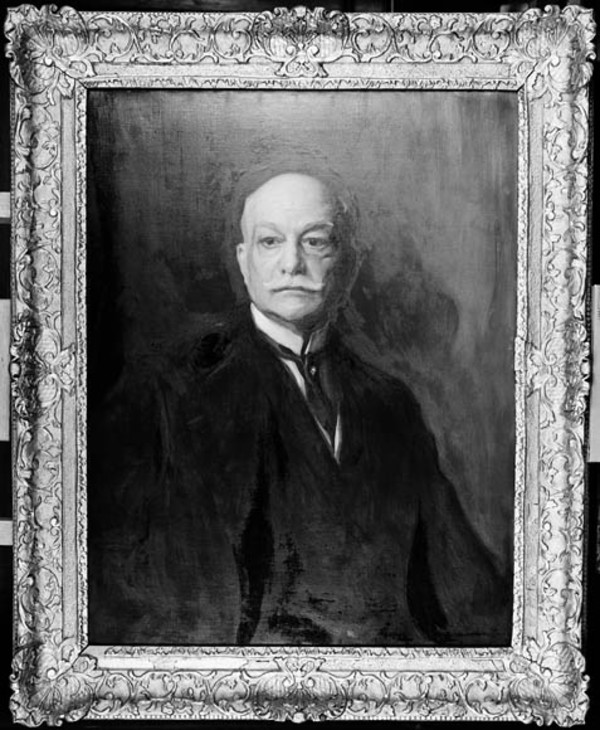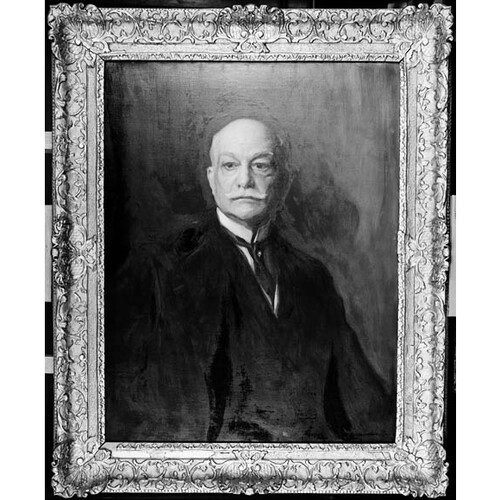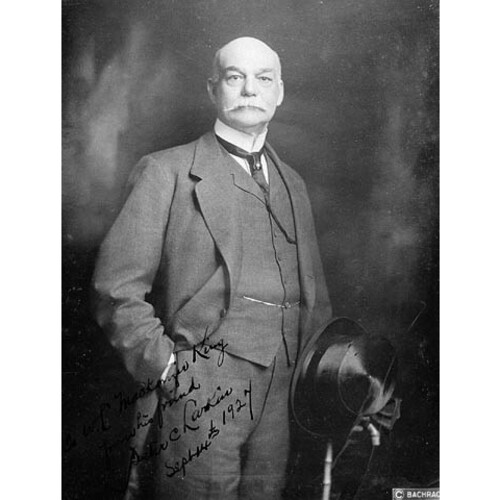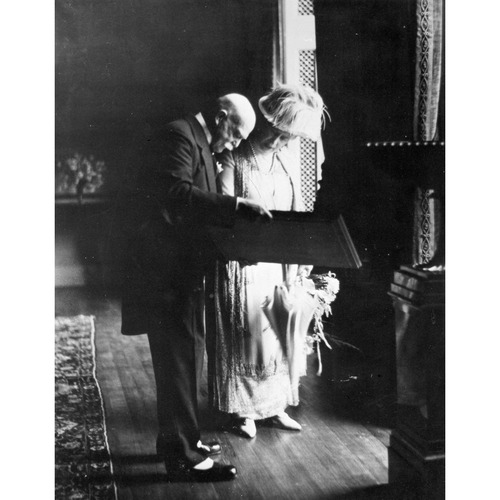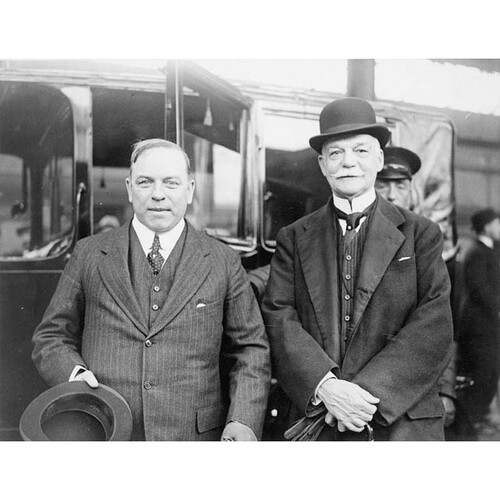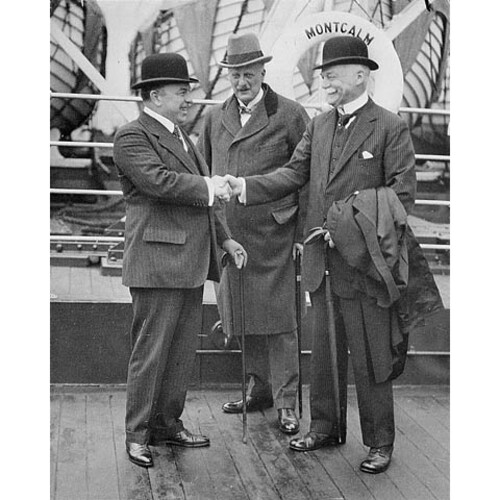LARKIN, PETER CHARLES, businessman and diplomat; b. 14 May 1855 in Montreal, son of Michael Larkin and Sarah McGill; m. 27 June 1883 Hannah Jean Ross in Cobourg, Ont., and they had one son and one daughter; d. 3 Feb. 1930 in London, England.
Peter Larkin always gave his date of birth incorrectly as 13 May 1856. Little is known about his early life and upbringing in what undoubtedly were modest circumstances. His father, a bricklayer, died when he was seven; his mother worked as a charwoman. He received his primary education in Montreal, and is said to have had some training in Toronto. Perhaps this occurred in the evenings after he moved there in his twenties. Young Peter’s business career had begun when he went to work at age 13 for a retail grocer. By 1875–76 Montreal directories listed him as a bookkeeper for an unnamed employer. About 1877 he joined Tiffin Brothers, a grocery wholesaler in Montreal, as a commercial traveller calling on customers from Halifax to Winnipeg. At the time of his marriage he was based in Toronto.
In 1889 he left Tiffin Brothers to start his own business in Toronto as a tea broker and wholesaler of sugar, dried fruits, and nuts. An early indication of his commercial ability and shrewdness came two years later after he had fallen out with the city’s Wholesale Grocers’ Guild over his refusal to maintain the prices for granulated sugar its members had agreed upon. They were unable to match either the lower expenses he achieved by stocking a narrow line of high-volume items or the flexibility he gained by using public warehouses. Larkin’s main interest, however, remained the tea trade, and soon it demanded almost his entire attention.
Beginning in the 1880s public taste in Britain, and in Canada, turned away markedly from the increasingly adulterated green teas of China and Japan toward the more robust black teas of India and Ceylon (Sri Lanka). Between 1882 and 1892 imports of China tea into Britain declined from 114 million pounds to 34, while imports from the Indian subcontinent rose from 31.5 million to 173. As well, the old way of selling tea, from open, lead-lined chests where it was prone to absorb strong odours in a grocer’s shop, began to be superseded about 1890 by its sale in small, sealed, lead-foil packets.
Although Larkin was neither the first to introduce India and Ceylon teas to Canada nor the first to supply them in packets, he was in the vanguard of innovators and certainly the earliest importer to mix his own blends, which were marketed with a skill and drive unmatched by his competitors. As early as 1891 he advertised Ceylon tea in 50-pound chests to the grocery trade. A year later he refined his line by blending Ceylon teas and offering them to grocers in pound and half-pound packages as the Golden Teapot Blend from “The Salada Tea Co., L’td., Ceylon.” No evidence has been found that this company, said to be named for a tea-growing district in India, was other than Larkin’s invention. All mention of Golden Teapot Blend was soon dropped and Salada went on to become one of the strongest brand names in the Canadian and American markets.
Larkin’s marketing strategy was to appoint agents to sell his product and to support them with extensive newspaper publicity. “In advertising,” he said, “be sure you have the right article first, then don’t spare the printer’s ink.” As of May 1893 more than 200 Toronto grocers stocked Salada. A year later, when sales in the city had grown to exceed those of all other packaged teas combined, Larkin turned his attention outside Toronto and rapidly signed up grocers throughout southern Ontario. Week after week the Canadian Grocer (Toronto) reported, like a railway conductor calling out stops, the towns where agents had been appointed. His next target was Montreal, where, within four months, some 225 accounts had been opened. By May 1895 Larkin boasted nearly 2,000 agents in eastern Canada; sales volumes were more than double those of the year before. With the opening of a wholesale depot in Vancouver in 1896, Salada gained national distribution. Backed by advertising in some 340 daily and weekly newspapers, it quickly captured about 75 per cent of the sales of packaged tea in the country.
As his brand’s share of its market neared saturation, Larkin had a choice, either of slower growth as packaged tea made inroads on bulk sales, which still accounted for 85 per cent of Canada’s black-tea market, or of expanding to the United States. He chose the latter, though per capita consumption of tea there was much lower than in Canada. His first American branch opened in Buffalo, N.Y., in mid 1896; others followed in quick succession in Pittsburgh, Boston, Rochester, and Detroit. The hub of his American business, however, was Boston. By early 1898 more than 500 grocers in that city and its suburbs were handling Salada.
Until 1900 Larkin’s business – styled P. C. Larkin and Company, but usually known as the Salada Tea Company – was organized as a sole proprietorship. In that year the Salada Tea Company Limited was incorporated with 40,000 shares having a par value of $10 each. Larkin held all the shares except those needed by his wife and accountant to qualify as directors. Salada’s offices and factory were then at 32 Yonge Street, Toronto, in a building acquired in 1898 after fire had damaged Larkin’s previous quarters and stock. His income from tea was augmented by sales of his patented invention, the Ideal tea packer, which enabled three men to turn out 20,000 half-pound packages of tea per week. Even competitors such as Thomas J. Lipton Company acquired Ideal packers for their own use. By 1899, when Larkin was invited to join George Albertus Cox*, William Mulock*, Timothy Eaton* and others in buying shares to support Joseph E. Atkinson*’s bid for control of the Toronto Daily Star, it was clear he had become a wealthy man. A few years later he was said to be the “heaviest insured man” in Canada.
Earlier, in the mid 1890s when Atkinson was the Toronto Globe’s Ottawa correspondent, he had interviewed Larkin about the Liberal party’s policy of unrestricted reciprocity. Likely the tea merchant’s opinion was sought not only because he was a leading businessman but also because he was a known supporter of the party and its charismatic leader, Wilfrid Laurier*. While Larkin might doubt as late as 1899 that Laurier would remember him from their few previous contacts, this uncertainty was unwarranted by September 1905, when Larkin became treasurer of the General Reform Association of Ontario, a position he would hold for several years. In 1909 he helped found the Ontario Club, the party’s chief social establishment in Toronto; he was its president in 1911–12. Following the Imperial Conference of 1911, which recommended a British royal commission on the natural resources, trade, and legislation of the dominions, he was appointed Canada’s representative on the commission. Barely two months later, after the Liberals were soundly defeated in a general election by Robert Laird Borden*’s Conservatives, George Eulas Foster*, the new minister of trade and commerce, lost no time in replacing Larkin.
Larkin’s essentially benevolent view of life had been reflected in the other endeavours in which he was active during the century’s first decade. In 1904, on the initiative of Joseph Wesley Flavelle*, chairman of the Toronto General Hospital, Larkin was appointed to its board of trustees. For 17 years he would throw himself into the hospital’s affairs as a member of several committees and as vice-chairman of the board, retiring with Flavelle only after the large new hospital built near Queen’s Park had been finished and was free of debt. In 1909 Larkin became president of the Toronto League for the Prevention of Tuberculosis; he served in this capacity for 20 years and gave heavily of his time and funds to its work. In addition, he was credited in obituaries with being the first prominent person to advocate a system of old-age pensions, which took shape in parliament as the Government Annuities Act of 1908.
For all Larkin’s involvement in politics, he was more comfortable as a power behind the throne rather than on it. Before the Liberals lost office in 1911, he was often spoken of as a possible senator. As Laurier went about rebuilding the party after the election, the two men became close friends. When Laurier visited Toronto he usually stayed at the Larkins’ house on Elm Avenue in Rosedale. After the conscription issue split the country in 1917, Larkin was one of the few Ontario Liberals who backed their leader in opposing forced military service. He even resigned over the issue from the board of the Globe, where he had sat for almost ten years. Yet when it was suggested that he contest a seat in the election of December 1917, he declined on the grounds that his business could hardly do without him.
Larkin had a point. Though exact figures are not available, Salada Tea’s volume had increased between five and ten times since 1900. He prided himself on being known as “The Tea King of America,” in tribute to the company’s domination of markets north and south of the border. Soon after World War I broke out, however, an embargo on tea exports from England made the company dependent on shipments direct from Ceylon and India, which took three months to arrive. To protect against any interruption in its supplies, Salada bought in unusually large quantities, borrowing heavily from its bankers to finance the purchases. Five or six years before the war Larkin had begun to turn over the day-to-day management of his company to his son, Gerald Ross, but when Gerald and more than two dozen key employees enlisted to fight in Europe, Larkin was forced to resume detailed charge. At one point his tea-taster in Boston joined up and he had to take the man’s place for a while.
In the aftermath of the 1917 election, which was a disaster for the Liberals, Laurier again set about reviving his party, though illness began to hobble him the following summer. One of the last letters he received before his death in February 1919 came from Larkin asking if a seat in parliament could be found for William Lyon Mackenzie King*, who had been defeated in the election (despite Larkin’s financial backing), to avoid losing his talents to the United States. As events unfolded, King was chosen to succeed Laurier as leader in August, and he was returned to the House of Commons in a by-election two months later. He then led the opposition until the Liberals squeaked into office in December 1921.
One of King’s first acts in power was to make Larkin Canada’s high commissioner in London in place of Sir George Halsey Perley*, who had retired after the election. The appointment, the highest within the gift of the government, was gazetted on 10 Feb. 1922, when Larkin was also sworn in as a privy councillor for Canada. In offering him the post, King had played down his influence by saying he was only carrying out Laurier’s wish and expressed belief that “there is nothing too good for our friend Larkin.” Although there were some grumblings – George MacKinnon Wrong* of the University of Toronto had advised King not to pick someone with such limited formal education – on the whole bipartisan approval greeted the appointment. Larkin was thought by most to have the intelligence and urbanity to do Canada credit, as well as a business reputation the British would respect. He was tall and patrician, with coal-black eyes, a full, white moustache, and a well-formed head that had been bald since his thirties. Known for being particularly well-dressed, he usually wore formal attire with a black silk hat. Asked to describe himself, he said he was a “plain, blunt man,” like Mark Antony, but drew attention to his literary tastes, the experience he had gained from travelling to Europe annually for many years, and his considerable knowledge of art and architecture. The prime minister had benefited from Larkin’s interest in the decorative arts after Lady Laurier left her house in Ottawa to the Liberal party as an official residence for its leader. Larkin contributed heavily to the costs of renovation and provided much of the furniture for the public rooms from a stock of Adam, Hepplewhite, and Sheraton pieces he had gathered in a Montreal warehouse. His involvement foreshadowed his role in creating Canada House in London.
When Larkin was appointed, it was made clear that the high commissioner would communicate directly with the prime minister on all matters of public policy, and avoid any gatherings of British officials and high commissioners that might pull Canada into a commitment to British foreign policy. Larkin was later quoted as saying, “The people of Canada think the high commissioner for Canada is a person of some importance in London. He is not.” Since he shared King’s sense of Canadian autonomy and his mistrust of the British government, Larkin was quite willing to conform to his prime minister’s expectations. This understanding reflected not only the similarity of views and close ties between the two men, but also King’s desire to exercise control over matters at a time when Canada’s relationships with Britain and the other dominions were being redefined. To reinforce the chain of command, an order in council was passed concurrent with Larkin’s appointment placing all agencies of the Canadian government in the United Kingdom under the high commissioner. On 23 April, barely two weeks after Larkin arrived in Britain, he wrote to King proposing that things be taken to their logical conclusion by concentrating all operations under one roof. The proposal soon became mixed up in the simmering issue of whether provincial agents-general in London would be recognized as equals to the high commissioner in matters where the British North America Act accorded powers to the provinces. After Frederick Coate Wade, British Columbia’s aggressive agent-general, was found to be using his influence against the sale of his province’s well-located quarters to the Canadian government, which already leased part of it, King wrote Larkin on 22 June 1922 that he was not inclined “to go particularly out of my way towards seeking any added status for the representatives of the provinces in London.” Finding an alternative site took Larkin another year, but the delay was well worth the wait when he secured from the Union Club its distinguished building on Trafalgar Square. Canada House was opened by King George V on 29 June 1925. The consolidation there of Canadian offices soon strained relations with the trade commissioners in Britain of the Department of Trade and Commerce, in part because the move facilitated Larkin’s periodic interference in trade matters.
Meanwhile, there were other issues demanding the high commissioner’s attention, including the lifting of a 30-year embargo on the importation of live cattle into Britain, settling Britain’s war debt to Canada, and preparations for the British Empire exhibitions of 1924 and 1925. In addition, the high commissionship committed the Larkins to incessant socializing. Jean Larkin’s contribution was the hosting of weekly receptions in their residence at Lancaster Gate, London. That King was grateful for such diligent work, not to mention Peter Larkin’s financial support, is clear from the long and sentimental letter the prime minister, exhausted by constitutional tilting with Governor General Lord Byng*, wrote Larkin on New Year’s Eve 1926. “I have no living friend for whom I have a greater or truer regard than for yourself,” King told him. Although Larkin would continue to serve for another four years, until his death, King’s words were a fitting tribute to his work as high commissioner.
Larkin died of a heart attack in 1930. After a memorial service at Christchurch, Lancaster Gate, his cremated remains were returned to Toronto for burial. Subsequently, uncashed cheques for his salary from the government were found in his desk. With an income said to have reached $650,000 annually from the Salada Tea Company, which during the 1920s had grown under Gerald Larkin’s management to be the third-largest supplier of teas in the world, Peter Larkin had asked no more from his country than the honour of serving it.
ANQ-M, CE601–S51, 20 mai 1855. AO, MU 2637, no.86; RG 8-1-1, file 4408; RG 55-1, 58: 98; RG 80-3-2-31, no.901673; RG 80-5-0-118, no.8616. City of Toronto Arch., RG 5, F (assessment rolls), sub-ser.1, 1834–1951, St Lawrence Ward, 1 Oct. 1889. NA, MG 26, G, 32019–22, 197578–80, 202509–12; MG 26, J1, 20: 18664–65; 76: 64254, 64256–57, 64283–85, 64361, 64462; 133: 113612–16; MG 27, III, E1; RG 32, C2, 331, file 1856. Evening Telegram (Toronto), 4 Feb. 1930. Gazette (Montreal), 3–4, 6 Feb. 1930. Globe, 4 Feb. 1930. Montreal Daily Star, 10 Feb. 1922. Toronto Daily Star, 3 Jan. 1931. Canadian annual rev., 1905, 1922. Canadian Grocer (Toronto), 1890–98. Canadian men and women of the time (Morgan; 1912). R. MacG. Dawson and H. B. Neatby, William Lyon Mackenzie King: a political biography (3v., Toronto, 1958–76), 2: 40–41. Directory, Montreal, 1854–62/63, 1867/68, 1875/76–76/77. Nancy Gelber, Canada in London: an unofficial glimpse of Canada’s sixteen high commissioners, 1880–1980 (London, [1980]). Ross Harkness, J. E. Atkinson of the “Star” (Toronto, 1963). O. M. Hill, Canada’s salesman to the world: the Department of Trade and Commerce, 1892-1939 (Montreal and London, 1977). [C.] V. Massey, What’s past is prologue: the memoirs of the Right Honourable Vincent Massey, c.h. (Toronto, 1963). J. E. Middleton, The municipality of Toronto: a history (3v., Toronto and New York, 1923), 2: 783. Peter Oliver, G. Howard Ferguson: Ontario Tory (Toronto and Buffalo, N.Y., 1977). J. E.Saunders, “The Honourable Peter Charles Larkin, collector, philanthropist, and fifth high commissioner for Canada in London: a study on Canadian collecting in the decorative arts” (ma thesis, Bard Graduate Center for Studies in the Decorative Arts, New York, 1999).
Cite This Article
Stephen A. Otto, “LARKIN, PETER CHARLES,” in Dictionary of Canadian Biography, vol. 15, University of Toronto/Université Laval, 2003–, accessed April 27, 2025, https://www.biographi.ca/en/bio/larkin_peter_charles_15E.html.
The citation above shows the format for footnotes and endnotes according to the Chicago manual of style (16th edition). Information to be used in other citation formats:
| Permalink: | https://www.biographi.ca/en/bio/larkin_peter_charles_15E.html |
| Author of Article: | Stephen A. Otto |
| Title of Article: | LARKIN, PETER CHARLES |
| Publication Name: | Dictionary of Canadian Biography, vol. 15 |
| Publisher: | University of Toronto/Université Laval |
| Year of revision: | 2005 |
| Access Date: | April 27, 2025 |


